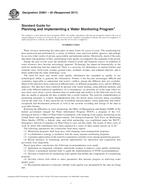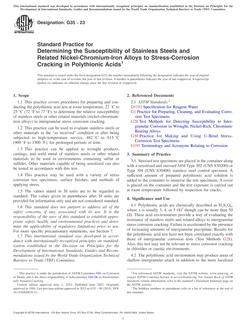
ASTM D5851-95(2011)
1.1 Purpose – This guide is generic in its application to surface or ground water, rivers, lakes, or estuaries (quantity and quality). It proposes a series of options that offer direction without recommending a definite course of action and discusses the major elements that are common to all purposes of water monitoring.
1.2 The elements described are applicable whether the monitoring is only for one location or integrates multiple measurement sites for the purpose of assessing a whole watershed, estuary, or aquifer system.
1.3 This guide is intended to outline for planners and administrators the components, process, and procedures which should be considered when proposing, planning, or implementing a monitoring program. The guide is not a substitute for obtaining specific technical advice. The reader is not assumed to be a technical practitioner in the water field; however, practitioners will find it a good summary of practice and a handy checklist. Other standard guides have or will be prepared that address the necessary detail.
1.4 Monitoring Components – A water monitoring program is composed of a set of activities, practices, and procedures designed to collect reliable information of known accuracy and precision concerning a particular water resource in order to achieve a specific goal or purpose. The purposes may range in scope from tracking status and trends on a regional or national basis to gathering data to determine the effects of a specific management practice or pollution incident such as a spill. This guide suggests and discusses the following process and components:
Product Details
- Published:
- 05/01/2011
- Number of Pages:
- 9
- File Size:
- 1 file , 130 KB
- Redline File Size:
- 2 files , 270 KB

